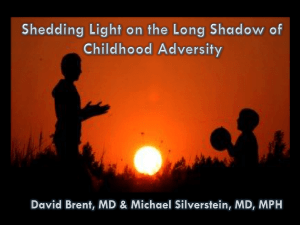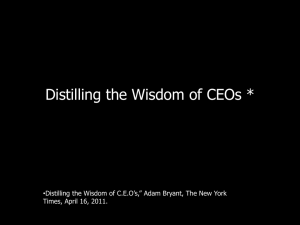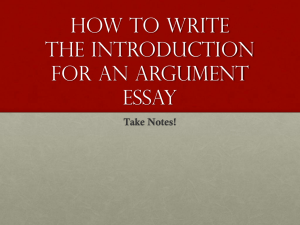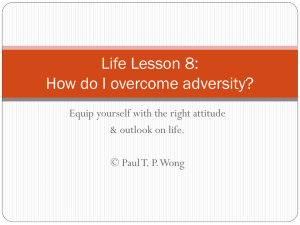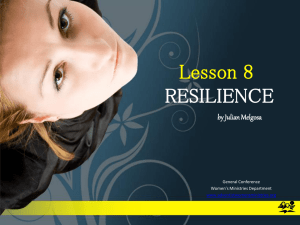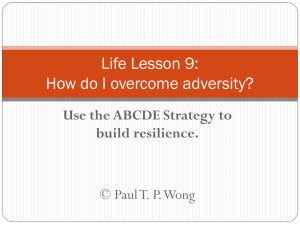"That Which Does Not Kill Me, Makes Me Stronger"...and Weaker
advertisement
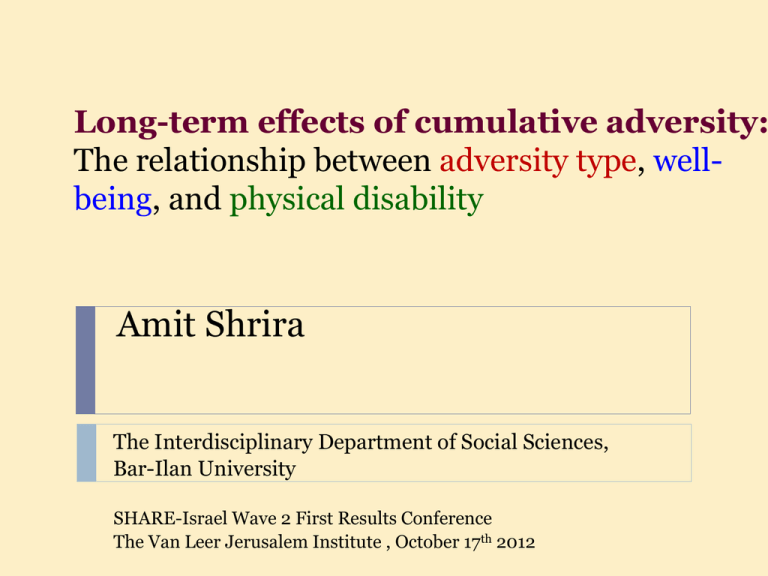
Long-term effects of cumulative adversity: The relationship between adversity type, wellbeing, and physical disability Amit Shrira The Interdisciplinary Department of Social Sciences, Bar-Ilan University SHARE-Israel Wave 2 First Results Conference The Van Leer Jerusalem Institute , October 17th 2012 Pablo Picasso (1937) Guernica Cumulative Adversity Definition: Exposure to a wide spectrum of potentially traumatic events Depletion vs. Inoculation: Exposure to adverse life events may generate vulnerability, but may also foster resilience (Bonanno et al, 2011; Ryff et al., 2012; Seery et al., 2010) Cross-sectional analyses on cumulative adversity in SHARE-Israel – reported in: Shmotkin, D., & Litwin, H. (2009). Cumulative adversity and depressive symptoms among older adults in Israel: The differential roles of selforiented versus other-oriented events of potential trauma. Social Psychiatry and Psychiatric Epidemiology, 44, 989-997. Shrira, A., Palgi, Y., Ben-Ezra, M., & Shmotkin, D. (2011). How do subjective well-being and meaning in life interact in the hostile world? Journal of Positive Psychology, 6, 273-285. Shrira, A., Shmotkin, D., & Litwin, H. (2012). Trauma at different points in the life course and current mental health: Findings from SHAREIsrael. American Journal of Orthopsychiatry, 82, 251-259. Keinan, G., Shrira, A., & Shmotkin, D. (2012). The association between cumulative adversity and mental health: Considering dose and primary focus of adversity. Quality of Life Research, 21, 1149-1158. Study aim: To examine whether cumulative adversity (reported at W1) predicts W2 well-being and physical disability, focusing primarily on (1) Different types of adversity (2) The moderating effect of distress (depressive symptoms) (1) Different types of adversity Self vs. Other: A largely overlooked distinction made by the DSM-IV (1994) in the definition of traumatic event “The person experienced or witnessed or was confronted with an event or events that involved actual or threatened death or serious injury, or a threat to the physical integrity of self or others”. Self-oriented adversity Frida Kahlo (1946) The little deer Other-oriented adversity Michelangelo (1498-99) Pietà The potentially traumatic infliction primarily targets the self The potentially traumatic infliction affects the self by primarily targeting others (e.g., being at risk of death due to illness or accident, being a victim of violence) (e.g., witnessing people killed, learning about the death of a loved one) Further dividing adversity type, as suggested by Shmotkin (2008) Bereavement & health vulnerabilities are “on time events” (Neugarten, 1996). Yet, evidence suggest they have a stronger effect on late-life well-being than other adversity types (e.g., Kraaij et al., 2002) (2) The moderating effect of depressive symptoms Cumulative adversity has a small to medium effect on functioning, and most older adults remain resilient even when experiencing many adverse events throughout life (Ferraro & Shippee, 2009; Kraaij et al., 2002) Yet, those who suffer high levels of distress (i.e., neuroticism) are more sensitive to the accumulation of adverse events (e.g., Kendler et al., 2004) Hypotheses: (1) Cumulative adversity would predict lower well-being and higher physical disability in W2 Cumulative adversity would have a strong negative effect on W2 outcomes when focusing on: (2) Self-oriented adversity rather than on otheroriented adversity (3) Bereavement and health vulnerabilities rather than on other event types (4) Those who reported high level of depressive symptoms rather then on their low-level depressive symptom counterparts Participants 1,248 respondents from SHARE-Israel Drop-Off sample who participated in both W1 and W2 Mean age=62.5 (SD=9.7), 57.2% women; 73.4% Israeli veteran Jews, 6.2% from former USSR, 20.4% Arab Israelis; average education level of upper secondary education Measures *** W1 Predictors *** 1) Cumulative adversity: various summations of events reported from a list of 17 difficult life events (Shmotkin, 2008) were used to create (a) overall adversity; (b) self/other-oriented adversity (c) bereavement/health/war-terror/victimization 2) Depressive symptoms: sum of symptoms reported from a list of 12, dichotomized to 0-3 (n=874) and 4+ (n=372) (Euro-D; Prince et al., 1999) (KR-20=.77) *** W2 Outcome measures *** 1) Life satisfaction: a single item with a 0-10 scale 2) Quality of life: CASP-12 (Hyde et al., 2003) – 12 items. (α=.82) 3) Activities of daily living (ADL) (Katz et al., 1970) – 6 daily activities (KR-20=.90) 4) Instrumental activities of daily living (IADL) (Lawton & Brody, 1969) – 7 daily tasks (KR-20=.83) RESULTS The relationship between W1 adversity indices and W2 outcome measures Note. N=1248. Y axis values refer to standardized regression coefficients (βs) after controlling for age, gender, origin, and education. *p<.05, **p<.001, ***p<.0001 The Cumulative adversity X Depressive symptoms Interaction for predicting W2 life satisfaction and ADL Blue slope=Low level of depressive symptoms (EURO-D < 4) Red slope=High level of depressive symptoms (Euro-D ≥ 4) Note. Similar interactions were found for quality of life and IADL. Interactions remained significant after controlling for age, gender, origin, education, and the main effects of cumulative adversity and depressive symptoms. Summary and conclusions: A differential outlook on cumulative adversity Cumulative adversity, especially healthrelated self-oriented adversity, predicts lower well-being and higher physical disability. Other-oriented adversity, with the exception of bereavement, does not affect well-being and physical disability. Although most Israeli older adults are resilient to cumulative adversity, those who suffer from high level of depressive symptoms are especially sensitive to the negative effects of adversity. THANK YOU! Potentially Traumatic Events Inventory Events Bereavement Experienced the death of a spouse (O) 159 Experienced the death of a child or grandchild (O) 136 Had a loved one at risk of death due to illness or accident (O) Health/ life hardships Experienced extremely severe economic deprivation (S) War/terror N 471 278 Was at risk of death due to illness or serious accident (S) 179 Needed long term care due to difficulty in caring for herself/himself (S) 112 Provided long term care to a disabled or impaired relative (O) 445 Lost a loved one in a war or in military service (O) 259 Witnessed the serious injury /death of someone in war or military action (O) 185 Experienced the injury or the death of a loved one in a terrorist act (O) 90 Was wounded in war or military action (S) 66 Witnessed a terrorist act in which she/he was not harmed personally (O) 64 Was wounded in a terrorist act (an attack by terrorists against civilians) (S) 14 Victimization Was the victim of crime (such as robbery ) (S) 117 Witnessed an accident in which someone was seriously injured/killed (O) 116 Was the victim of violence or abuse (S) 35 Experienced sexual assault (rape or harassment) (S) 26
